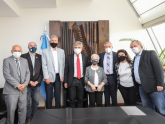The Minister of Foreign Affairs, Felipe Solá, and the Secretary of Malvinas, Antarctica and South Atlantic of the Ministry of Foreign Affairs, Daniel Filmus, together with relatives of fallen and veterans of the Malvinas War, accompanied from Buenos Aires the agreement signed at the International Committee of the Red Cross (ICRC) headquarters in Geneva, initiating the second phase of the humanitarian initiative that will advance in the identification of Argentine soldiers fallen in Malvinas.
In the same humanitarian spirit of the first phase, which began in 2012, the agreements signed last March 18 are intended to identify the remains of soldiers who rest in mass grave C.1.10 in the Malvinas Islands Darwin Cemetery.
The Minister of Foreign Affairs stated that he was “very proud of this work”. “That land is sacred land and that word perhaps expresses the great importance of recovering years later the identity of those who led down their lives. What the President, the Argentine Forensic Anthropology Team, and those who work in Geneva and the Red Cross are doing today is a sacred fact”.
“The efforts are enormous and we need the task to be completed because although the peace of the families is never complete, it is important that they do not feel alone and that they can identify the soldiers”, said the Minister of Foreign Affairs, adding that “we are going to continue fighting for our sovereignty rights over the islands in peace, in the terms established by the United Nations resolutions”.
For his part, Filmus highlighted that this humanitarian project “is a State policy that Argentina has maintained since 2012, that goes beyond governments and which has already allowed, after many years of waiting, that 115 families can identify and pay homage to their loved ones that gave their life to recover the exercise of sovereignty over the Malvinas Islands”.
The agreements were signed at the ICRC headquarters by the Argentine Ambassador to International Organizations in Geneva, Federico Villegas, his British counterpart and ICRC President Peter Maurer. Argentina, the United Kingdom and the International Committee of the Red Cross also established a new Humanitarian Project Plan with the legal framework and all the technical details of the forensic tasks that will be required.
It is estimated that the identification tasks in mass grave C.1.10 in the Darwin Cemetery will begin in August. This grave had been excluded from the scope of the Humanitarian Project Plan carried out in 2017 because it was not an anonymous grave. The plaque put up in 2004 bore the name of the First Ensign of the National Gendarmerie Julio Ricardo Sánchez, as well as the soldiers of the Air Force Héctor Aguirre, Luis Sevilla and Mario Luna.
After collecting DNA samples from relatives of the three soldiers, it was found, in 2018, that their remains were actually buried in three individual graves, which remained under a plaque that read “Argentine Soldier only known to God”. This finding evidenced the need to clarify the identity of the remains buried in grave C.1.10.
This event represents the continuity of a policy that has as a precedent the tasks undertaken by the National Government in 2012, when it requested the collaboration of the International Committee of the Red Cross (ICRC) in order to identify 122 graves of Argentine soldiers buried in the Darwin Cemetery and formed a roundtable composed of the Ministry of Foreign Affairs, the Ministry of Justice, the Argentine Forensic Anthropology Team, the General Government Notary’s Office and the Ministry of Social Development. The first humanitarian initiative was successfully completed. 115 soldiers were identified, thereby giving an answer to many families who longed to know the exact resting place of their loved ones.


